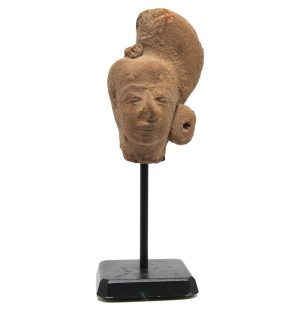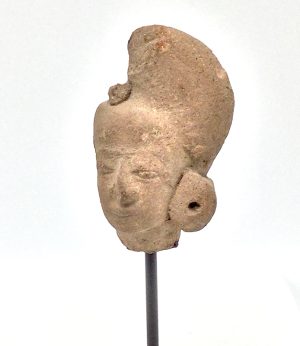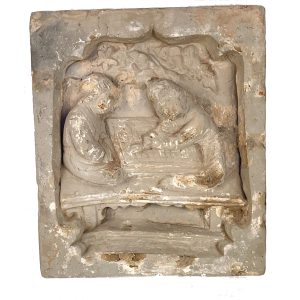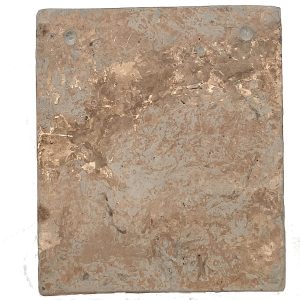Showing 13–24 of 31 results
-
Sale!


$325.00 Original price was: $325.00.$235.00Current price is: $235.00.
H: 2.675” DIA: 3” | FREE SHIPPING WITHIN CONTINENTAL U.S.!
This simple ancient small earthenware bowl was made in Africa Proconsularis, the Roman North Africa pottery center and distributed throughout the Roman Empire. With no handle, this beaker is beautiful in its simplicity resting on a short foot, a body that curves up and rises to meet a neck and is topped with an everted rim to lessen spillage Made for daily use, this Roman coarse wear has a wide mouth for easy drinking and a rim with light terracotta red and its crème slip with an exquisite shape.
-
Sale!


$625.00 Original price was: $625.00.$495.00Current price is: $495.00.
H: 8.5” Dia: 9.75” | FREE SHIPPING WITHIN CONTINENTAL U.S.!
Made in the Roman North Africa, this ancient carinated ceramic flagon called coarse wear for daily use made of inexpensive durable clay was used to hydrate all kinds of people and on home altars for offerings to family deities. Carinated pottery, where the top and lower sections are angled in opposite directions forming a pointed edge, was common ancient pottery shape, this one with a handle.
-
Sale!


$465.00 Original price was: $465.00.$365.00Current price is: $365.00.
H: 1.625” Dia: 10.125” | FREE SHIPPING WITHIN CONTINENTAL U.S.!
A fine ancient Roman platter produced for upper classes, this is refined and delicate and has stamped decorative images in complex circles. Although rough areas with small losses remain, it is an ancient piece otherwise in very good condition that, especially considering its age and use, remains a remarkable surviving piece of history.
-


$495.00
H: 3.125” W: 3” D: 2.875” | FREE SHIPPING IN CONTINENTAL U.S.!
Dating from the 4th century B.C.E., this miniature pottery vessel was wheel-thrown in the Greek colonies, Apulia, Magna Graecia in Southeastern Italy. Called Xenon ware, it’s elegant shape has a curved body, small neck with flared rim and handle and is decorated with painted orange geometric designs. Its diminutive shape indicates it may have been made for use by children or as a votive vessel. Common for pottery of this age there is some fading of the painted decoration and small chips. With no discernible repairs or restorations it is in very good shape for its age and use.
-


$85.00
H: 2” W: 1.75” D: 4” | FREE SHIPPING WITHIN CONTINENTAL U.S.!
Antique and vintage ceramic tobacco pipes are part of a long cultural tradition of Burmese/Myanmar and Thai hill tribes. Mould made and adorned with intricate designs, a bamboo or metal stem was often inserted at the end through which smoke was drawn. This highly collectible antique item reflects hill-tribe skills creating decorative functional objects and would be a unique gift for any pipe smoker, but, like all antique items, we recommended it be used as a decorative item.
-


$105.00
H: 1.875” W: 1.75” D: 4” | FREE SHIPPING!
Antique and vintage ceramic tobacco pipes are part of a long cultural tradition of Burmese/Myanmar and Thai hill tribes. Mould made and adorned with intricate designs, a bamboo or metal stem was often inserted at the end through which smoke was drawn. This highly collectible antique item reflects hill-tribe skills creating decorative functional objects and would be a unique gift for any pipe smoker, but, like all antique items, we recommended it be used as a decorative item.
-


$85.00
H: 2” W: 1.75” D: 4” | FREE SHIPPING!
Antique and vintage ceramic tobacco pipes are part of a long cultural tradition of Burmese/Myanmar and Thai hill tribes. Mould made and adorned with intricate designs, a bamboo or metal stem was often inserted at the end through which smoke was drawn. This highly collectible antique item reflects hill-tribe skills creating decorative functional objects and would be a unique gift for any pipe smoker, but, like all antique items, we recommended it be used as a decorative item.
-


$195.00
Ht: 4” W: 1.5” D: 1.75”|FREE SHIPPING WITHIN CONTINENTAL U.S.!
This terracotta head was crafted during the Majapahit Empire in Java and was either part of a Hindu bas-relief frieze or made as a freestanding figurine. Most figures found are small decapitated heads with no bodies, and it is very rare to find a complete figure with a naturalistic facial expression. As with many heads, this one displays Javanese facial features, hairstyles and ear ornamentation typical of the period. It has a naturalistic facial expression and wears large round coiled earrings, possibly suggesting it represented someone of the upper classes. It is in very good condition given its age and use and is mounted on a metal stand. This items pairs with Majapahit Terracotta Head 1137.
-


$395.00
In China a set of earthenware Zodiac attendant figures was made as a 12 piece grouping, with each figure holding a small calendar animal with each year represented by a different animal – rat, ox, tiger, rabbit, dragon, snake, horse, goat, monkey, rooster, dog, and pig or boar – in a repeating 12-year cycle. Although…
-
Sale!


$475.00 Original price was: $475.00.$325.00Current price is: $325.00.
Ht: 6.875″ W: 5.25” D: 2.25 | FREE SHIPPING WITHIN CONTINENTAL U.S.!
This fascinating thick Song pottery brick is a low-fired depiction of a dwarf foreigner with a rotund belly, a large head and nose, an open mouth and abnormal features. The Chinese believed dwarfs could ward off evil spirits and sickness, attract peace and blessings (fu) and were very wise. Images of dwarfs became so popular, some were produced in numbers.
-
Sale!


$495.00 Original price was: $495.00.$395.00Current price is: $395.00.
H: 11” W: 9.5” \ D: 2” | FREE SHIPPING WITHIN CONTINENTAL U.S.
As part of the The Song dynasty cultural expansion, government and public buildings and tombs were built with interior walls decorated with earthenware unglazed mold-made brick tiles. This fanciful vibrant tile with a scalloped frame portrays two people playing a board game called wéiqí which originated in China over 2500 years ago. It is the world’s oldest and most complex board game still played.
-


$2,100.00
H: 11.75” W: 12.25” D: 7.5” | FOR SHIPPING INFORMATION CONTACT US AT 213-568-3030
Cocoon jars were mingqi made for placement in tombs to comfort the deceased on their journey to and in their afterlife. An elixir of Immortality made from mulberry leaves or their ashes was placed inside for the deceased to drink and transmigrate into the world of the beyond. Ovoid in shape to resemble a silkworm cocoon, ajar rests on a small trumpet-shaped foot and has a narrow neck and a wide lip at its mouth. Painted after firing with vertical bands dividing it into panels, swirling cloud scrolls, and circular “eye” motifs at each end, this beautiful vessel is in excellent condition for its age with expected paint losses, scrapes, and dirt adhesions.
End of content
End of content























